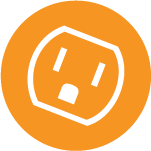Zone AC System: Optimizing Comfort
What is Zone Heating?
A Zoned AC System, also known as "Zoned HVAC," uses dampers in ductwork. These dampers help direct air to different areas of a building. When pushed through ductwork, the system regulates the airflow and temperature in each zone for customized comfort levels.
Air flows through the open dampers, closed dampers stop conditioned air from moving between zones. In some cases, the system may need to bypass excess air into the return or connecting areas like hallways.
In zone heating, warm air would work its way through you ductwork and into the room of your choosing. For zone cooling, cooled air would flow into a chosen room or zone.
There are 4 major aspects of zoning: the zone control panel, thermostat, dampers, and HVAC unit.
- HVAC Zone Control Panels are central controls used to communicate with duct dampers, thermostats, and your AC unit. Without the control panel, the zoning process will not function.
- Dampers wire into your duct system, opening and closing to control the airflow moving between specific rooms or zones. Designated thermostats operate the automatic dampers connecting to zones on the control panel. There are two types of dampers: manual dampers and automatic dampers.
- Thermostats measure the temperature in a room or area of your home. When the temperature falls below or above what you set, your thermostat sends signals to the control panel to adjust temps in that zone. Homes require multiple thermostats, one for each zone.
When should I consider AC Zoning?
Most modern homes can benefit from zone air conditioning systems but some more than others. You'll benefit the most from an HVAC zoning system if you have any combination of the following:
- A high ceiling
- A home with Large Windows
- A home with large floor plans
- A room rarely used or with limited traffic
- A room with one-purpose such as a gym or home office
- A building with significant temperature differences between floors
- A finished or unfinished basements
- A room above your garage
Buildings with any of the above features expect different levels of heating and cooling than homes without.
How many zones do I need?
To find how many zones you need ask an HVAC professional for help. You might have an idea of what rooms need zones but a pro can suggest the best way to do it. Consider adding a zone in rooms with vast temperature differences.
Ultimately, the final decision of how many zones you add is yours to make. Use your best judgement and always get a second (or even third) opinion on pricing and plans.
How Much Does HVAC zoning cost?
Costs of zoning changes depending on the amount of zones needed. You need a minimum of 2 zones, but eight or more can be supported. The number of thermostats and dampers also drive up prices.
Zone Air Conditioning Costs:
- 2-Zone: Between $1700 and $2800
- 3-Zone: Between $2200 and $3500
- 4-Zone: Between $2600 and $4500
- Additional Zones: Between $350 and $500 each
For a home with existing ductwork, expect all-in costs ranging from $4500 and $7000 in a standard 4-zone setup.
For homes with no ductwork, all-in costs for zoning can range from $5000 on the low-end up to $12500.
HVAC Damper Install Costs:
- Round Branch Dampers: From $70 to $180 each
- Large Trunk Dampers: From $150 and $340 each
Other factors that affect costs
Benefits of Zone HVAC Systems:
- Customized Comfort: Individually set temperatures per room (or zone), means meeting more specialized needs. Zoned HVAC systems also mean less fighting over what temperature the home should be.
- Better Air Quality: Filtered air can carry dirt and debris through the home, which lowers air quality. However, zoning dampers push air to intended rooms helping to prevent particulates from flowing through the entire house.
- Improved Energy Efficiency: Unlike central air, zoned HVAC system change the temperature in one area or room. Central air wastes energy heating or cooling the entire home, leading to higher energy bills. When combined with smart or programmable thermostats, zoned air conditioning can save up to 35% on energy costs.
Cons of Zone AC
- Higher Upfront Installation & Retrofitting Costs
- High Cost to Upgrade Existing Systems for ducting and system capacity increases
- Difficult to Diagnose Issues within the system
- More points of failure due to many working parts
The Verdict
A zoned AC system improves your home's comfort and saves energy, letting you control temperatures in different areas. Although the initial costs might be higher, the long-term energy savings and improved air quality may make it the best choice for your home.
Receive special deals and more, right to your inbox
Receive special deals and more, right to your inbox
